Related Research Articles

Thomas Tanner was an English antiquary and prelate. He was Bishop of St Asaph from 1732 to 1735.

Rev. Francis Blomefield, FSA, Rector of Fersfield in Norfolk, was an English antiquarian who wrote a county history of Norfolk: An Essay Towards a Topographical History of the County of Norfolk. It includes detailed accounts of the City of Norwich, the Borough of Thetford and all parishes in the southernmost Hundreds of Norfolk, but he died before completing it. This was done by a friend, Rev. Charles Parkin. The Norfolk historian Walter Rye related that although no portrait of him was known to exist, Blomefield closely resembled the astronomer John Flamsteed, whose portrait was used to depict Blomefield on the frontispiece of one of his volumes. His history of Norfolk was reissued in London in 11 volumes by William Miller in 1805–1810, the last seven being by Parkin.

The Cathedral Church of Saint Philip is the Church of England cathedral and the seat of the Bishop of Birmingham. Built as a parish church in the Baroque style by Thomas Archer, it was consecrated in 1715. Located on Colmore Row in central Birmingham, St Philip's later became the cathedral of the newly formed Diocese of Birmingham. The cathedral is a Grade I listed building.
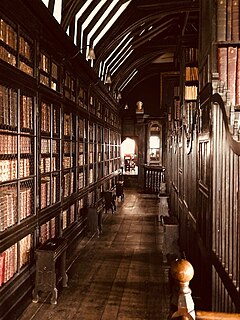
Chetham's Library in Manchester, England, is the oldest free public reference library in the English-speaking world. Chetham's Hospital, which contains both the library and Chetham's School of Music, was established in 1653 under the will of Humphrey Chetham (1580–1653), for the education of "the sons of honest, industrious and painful parents", and a library for the use of scholars. The library has been in continuous use since 1653. It operates as an independent charity, open to readers free of charge, Monday-Friday 09.00-12.30 and 13.30-16.30 by prior appointment. Tours of the Library for visitors are bookable online from 2 September 2019 via the Library website.

Norbury is a village and civil parish in the Borough of Stafford, in west Staffordshire, England. The population as taken at the 2011 census was 371.

Thomas Bray was an English clergyman and abolitionist who helped formally establish the Church of England in Maryland, as well as the Society for the Propagation of Christian Knowledge and Society for the Propagation of the Gospel in Foreign Parts.

Merton College Library is one of the earliest libraries in England and the oldest academic library in the world still in continuous daily use. The library is located in several parts of the college, and houses a priceless collection of early printed books and more than 300 medieval manuscripts. The historic collection was initially built through benefactions, including manuscripts donated by the medieval clergyman William Reade. The library also contains early printed books from the personal libraries of Griffin Higgs and Henry Kent, who originally donated approximately 600 and 800 volumes respectively. The main collection runs to approximately 70,000 volumes.
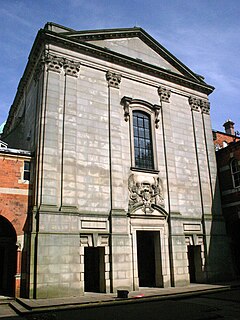
The Birmingham Oratory is an English Catholic religious community of the Congregation of the Oratory of St. Philip Neri, located in the Edgbaston area of Birmingham. The community was founded in 1849 by St. John Henry Newman, Cong.Orat., the first house of that congregation in England.
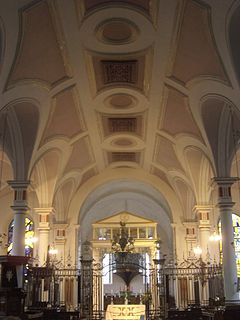
The Diocese of Derby is a Church of England diocese in the Province of Canterbury, roughly covering the same area as the County of Derbyshire. Its diocesan bishop is the Bishop of Derby whose seat (cathedra) is at Derby Cathedral. The diocesan bishop is assisted by one suffragan bishop, the Bishop of Repton.

A lending library is a library from which books and other media are lent out. The major classifications are endowed libraries, institutional libraries, public libraries, and subscription libraries. It may also refer to a library or other institution that sends materials on request to another library, usually via interlibrary loan.

The Francis Trigge Chained Library is a chained library in Grantham, Lincolnshire, England which was founded in 1598. Located in the parvise, over the south porch of St Wulfram's Church, it has been claimed to be "the first public library" in Britain.

St. Barnabas' Church is a Church of England parish church in Erdington in the north of Birmingham, England.

Beresford James Kidd was an Anglican priest and Church historian, who was Warden of Keble College, Oxford, from 1920 to 1939. He is best known for his History of the Church to A.D. 461, 3 vols., which with its very full references aimed at "putting students into direct contact with the sources and enabling them to use the originals for themselves".

The Church of St. John the Evangelist and St. Peter is a Grade II listed Church of England church of Ladywood, Birmingham, England.
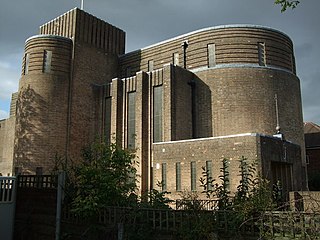
The Church of St Nicholas, Kingsway, Burnage, Manchester, is a Modernist church of 1930–2 by N. F. Cachemaille-Day, Lander and Welch. It was enlarged in 1964 with a bay on the west side, also by Cachemaille-Day. Pevsner describes the church as "a milestone in the history of church architecture in England". The church was designated a Grade II* listed building on 10 October 1980.
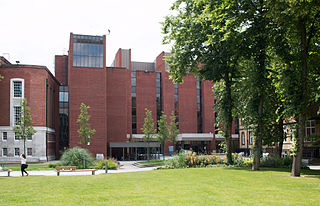
The University of Manchester Library is the library system and information service of the University of Manchester. The main library is on the Oxford Road campus of the university, with its entrance on Burlington Street. There are also ten other library sites, eight spread out across the University's campus, plus The John Rylands Library on Deansgate and the Ahmed Iqbal Ullah Race Relations Resource Centre situated inside Manchester Central Library.
Bishop Ryder Memorial Church, Birmingham, was a parish church in the Church of England in Birmingham from 1838 to 1960.
John Newey was an English churchman, Dean of Chichester from 1727 to 1735.

Wilfred Lawrence Knox (1886–1950) was an English Anglican priest and theologian, one of four brothers who distinguished themselves. After leaving Oxford with a first-class honours degree in classics, Knox soon began working with the poor of London's East End, and then studied for the priesthood. After brief parish work, he was warden of the Oratory of the Good Shepherd from 1924 to 1940, and chaplain and fellow of Pembroke College, Cambridge. He approached his New Testament studies as a Hellenist, and wrote several books on Paul the Apostle and other aspects of ecclesiastical history from that angle. He also wrote books explaining Anglo-Catholicism and the Christian way of life.

St John's Church, Manchester, also known as St John's, Deansgate, was an Anglican parish church in Manchester, England, established in 1769 and demolished in 1931. Its site is now that of St John's Gardens, situated between Lower Byrom Street, Byrom Street and Quay Street.
References
- 1 2 3 4 Ker, Neil Ripley; Perkin, Michael (2004), "BIRMINGHAM, Warwicks. (W. Mids.) St. Philip (from 1904 the Cathedral). Birm.", A Directory Of The Parochial Libraries Of The Church Of England And The Church In Wales, Oxford: Oxford University Press, p. 140, ISBN 0948170131 , retrieved 7 May 2012
- 1 2 3 4 Money, John (1977), Experience and identity: Birmingham and the West Midlands, 1760–1800, Manchester: Manchester University Press, p. 126, ISBN 0719006724 , retrieved 7 May 2012